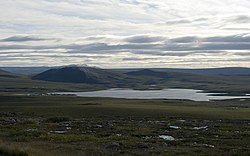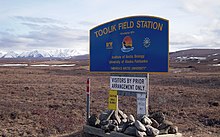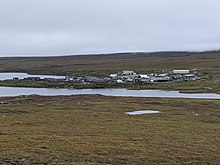Toolik Lake
Toolik Lake is an Arctic lake located within the North Slope Borough, Alaska. It is in a remote wilderness area managed by the Bureau of Land Management accessed by the Dalton Highway.[1] It is 130 mi (210 km) south of Prudhoe Bay in the northern foothills of the Brooks Range.[2]
| Toolik Lake | |
|---|---|
 Toolik Lake as photographed in 2016. Toolik Field Station is seen on the left. | |
 Toolik Lake | |
| Coordinates | 68.630692°N 149.610636°W |
| Type | Lake |
| Basin countries | United States |
| Managing agency | Bureau of Land Management |
| Surface area | 358 acres (1.45 km2) |
| Max. depth | 77 ft (23 m) |
| Surface elevation | 745 m (2,444 ft) |
.jpg)
.jpg)
Limnological studies of Toolik Lake began in the summer of 1975.[3] Research is performed by organizations such as the Global Lake Ecological Observatory Network,[4] Institute of Arctic Biology,[5] International Tundra Experiment,[6] National Ecological Observatory Network,[7] and NASA.[8]
Formation and characteristics
Lakes and ponds north of the Brooks Range, including Toolik Lake, were formed by retreating glaciers. Large masses of ice were left in their wake, and as they melted, lake basins were formed.[9]
Toolik Lake covers 358 acres (145 ha), and has a max depth of 77 ft (23 m).[10] The watershed of the lake is 63.7 km2.[7] Sunlight does not penetrate deep into the lake lake due to a high amount of dissolved organic matter. The lake may retain surface ice until late June and may refreeze as early as mid-September.[9] Since recordings began, the alkalinity of the lake has doubled. There has been an increase in dissolved calcium and magnesium flowing into the lake, caused by an increase in weathering of mineral soils that were previously frozen.[11]
Ecology
Toolik Lake is home to an active zooplankton community, primarily consisting of nanoflagellates, ciliates, rotifers, and copepods.[9] Five species of fish exist in the lake, including Arctic grayling, burbot, lake trout, round whitefish, and slimy sculpin.[12] Grayling, trout, and whitefish are recreationally fished.[10]
Tussock tundra dominates the terrain surrounding the lake. Other plant communities in the area include wet sedge tundra, as well drier heath tundra found at higher elevations.[13] Low growing shrubs are abundant, including birches and willows.[9] Trees are not present. Since surveys began, there has been a 19 percent increase in vascular vegetation abundance in the area around Toolik Lake, and plant canopy height and extent have been increasing. Conversely, moss and lichen abundance has seen a significant decrease.[11]
Over 80 species of birds may be observed from the lake during spring migration.[14][15]
Climate
Average monthly temperatures are below freezing for 9 months of the year. Only in June, July, and August do monthly average temperatures remain above freezing. Toolik experiences the midnight sun from June to August, while experiencing 24-hour darkness in December and January.[16] The mean annual precipitation is 331 mm (13.0 in).[7]
Lightning strikes have become much more prevalent in northern Alaska since the 1970s. In 2007, Alaska's largest recorded tundra fire was started by a lightning strike, occurring only 20 miles from Toolik.[17]
Toolik Lake Research Natural Area
The Toolik Lake Research Natural Area is the 82,800 acre area managed by the Bureau of Land Management surrounding Toolik Lake.[16] In 1991, it was designated as an Area of Critical Environmental Concern. Two rare plants are known to occur in the area; Claytoniella bostockii, and Erigeron muirii. In 2002, the Bureau of Land Management and the University of Alaska Museum Herbarium agreed to search at least 3,000 acres/year around the Toolik Lake Research Natural Area and the Galbraith Lake Outstanding Natural Area for rare plants.[18]
Camping is prohibited within the area.[10]
Toolik Field Station


The Toolik Field Station is an arctic research station located on the southeast shore of Toolik Lake. It is managed by the Institute of Arctic Biology at the University of Alaska Fairbanks (UAF).[5] The station is located on 33.87 acres of land, and can support a population of up to 175 researchers.[16] The National Science Foundation provides the station with $3 million a year to support operations.[17]
The station is supported by modern amenities, including generator produced electricity, running water and shower facilities, a sauna, a kitchen and dining facility, dormitory-style housing, heated garages, and full-service wet and dry chemistry labs.[16]
History
In June 1975, UAF placed the first structure on the lake to facilitate aquatic research. It was originally called the "University Toolik Camp".[19] The initial research focused on the trophic levels, biogeochemistry, and nutrient cycling of the lake. By 1979, both aquatic and terrestrial ecologists were studying the site. The scope of research broadened to include the growth rates and nutrient limitation of tundra vegetation.[6] The facility quickly grew too large for its location, and in 1983, it was moved and given its current name.[19] In 1987, Toolik was designated a Long-Term Ecological Research site.[3]
In the late 1980s, Toolik was studied as part of the Response, Resistance, Resilience, and Recovery from Disturbance (R4D) project supported by the United States Department of Energy and National Academy of Sciences. The goal of the project was to understand the effects of disturbance on tundra ecosystems.[6]
Through grants from the Department of Energy, Alaska State Legislature, and the National Science Foundation, the station has been upgraded considerably since its inception.[19]
References
- "The Tundra: Getting to Know the NEON Domains". ArcGIS StoryMaps. Retrieved 18 July 2020.
- "Monitoring Mixing Dynamics in Toolik Lake, Alaska". Campbell Scientific. Retrieved 18 July 2020.
- O’Brien, W. J. (1992). Toolik Lake: Ecology of an Aquatic Ecosystem in Arctic Alaska. Springer Netherlands. ISBN 978-9401052061. Retrieved 18 July 2020.
- "Toolik Lake | GLEON". GLEON. Retrieved 18 July 2020.
- "Toolik Lake & Toolik Field Station". Alaska.org. Retrieved 18 July 2020.
- Shaver, Gaius. "History Of Research at Toolik". Arctic Long Term Ecological Research. Retrieved 18 July 2020.
- "Toolik Lake - TOOK". NEON. Retrieved 18 July 2020.
- Voiland, Adam (10 July 2020). "Satellites Size Up Bubbles of Methane in Lake Ice". NASA Earth Observatory. Retrieved 18 July 2020.
- "Toolik Field Station Book". Arctic Long Term Ecological Research. Retrieved 19 July 2020.
- Sport Fishing Along the Dalton Highway (PDF). Fairbanks, Alaska: Alaska Department of Fish and Game Sport Fish Division, Region III. p. 13. Retrieved 19 July 2020.
- Hobbie, John E.; Shaver, Gaius R.; Rastetter, Edward B.; Cherry, Jessica E.; Goetz, Scott J.; Guay, Kevin C.; Gould, William A.; Kling, George W. (February 2017). "Ecosystem responses to climate change at a Low Arctic and a High Arctic long-term research site". Ambio. 46 (Suppl 1): 160–173. doi:10.1007/s13280-016-0870-x. ISSN 1654-7209. PMID 28116685. Retrieved 19 July 2020.
- "Toolik Field Station::Fish Guide". toolik.alaska.edu.
- "Global Fiducials Library Data Access Portal: GFP Site Description". gfl.usgs.gov. Retrieved 19 July 2020.
- "Toolik Field Station::Bird Monitoring". toolik.alaska.edu.
- "Toolik Field Station::Bird Guide". toolik.alaska.edu. Retrieved 19 July 2020.
- Toolik Field Station Long-Range Facilities Plan 2018 (PDF). National Science Foundation. December 2018. Retrieved 19 July 2020.
- Lindsey, Kelsey (10 September 2017). "As the Arctic warms, scientists at this remote field station try to make sense of the changing environment". Anchorage Daily News. Retrieved 19 July 2020.
- Carroll, Amy Breen; Parker, Carolyn; Craig, Tim (July 2003). Toolik Lake Research Natural Area / ACEC Rare Plant Inventory, 2002. Anchorage, Alaska: Bureau of Land Management. Retrieved 18 July 2020.
- "Toolik Field Station::History of Toolik". toolik.alaska.edu. Retrieved 18 July 2020.